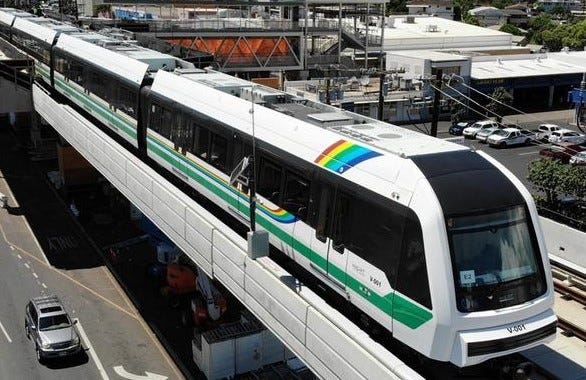
We’ve got some exciting news to share with you. After a series of setbacks, twists, and turns, the long-awaited Honolulu Light Rail Project, also known as HART (Honolulu Authority for Rapid Transportation), is finally gearing up for its grand opening this Friday, June 30th. It’s been a rollercoaster ride, but the positive outcome is just around the corner. The first 9 stations will be running from Kualaka`i East Kapolei to Hālawa Aloha Stadium Station. Let’s take a look at some of the key issues that have caused major delays for the project…
1. Construction Challenges and Permitting Woes
Constructing a light rail system from scratch is no small feat, especially in a bustling city like Honolulu. The HART project is the largest public works project in Hawaii’s history, and it’s no surprise that there were some construction problems along the way. Challenges included landslides, sinkholes, and problems with rail cars, as well as unanticipated utility relocations to unexpected geological conditions. Obtaining permits and approvals from various agencies also proved to be a complex process, causing delays that prolonged the project’s timeline.
2. Funding Hurdles and Budgetary Constraints
Financing a large-scale infrastructure project like HART was an ongoing challenge. As with any ambitious endeavor, securing sufficient funds played a crucial role in determining the project’s progress. Changes in the overall budget and funding sources added further complexities, leading to delays and adjustments in the project’s scope and timeline due to cost overruns. The original cost estimate for the HART project was $1.5 billion. But as the project went on, the cost kept rising. The latest estimate is that the project will cost $12 billion.
3. Legal Disputes, Lawsuits, and Political interference
Legal disputes can unfortunately be a common stumbling block in large-scale public projects. The Honolulu Light Rail Project faced its fair share of legal battles, ranging from procurement controversies to environmental concerns. Political interference has plagued the HART project seemingly from Day 1. It has been a political football for years. There have been changes in leadership, and the project has also faced a great deal of public opposition.
4. Community Engagement and Opposition
Engaging with the local community and addressing their concerns is vital for the success of any infrastructure project. HART faced significant opposition from some community members, who raised concerns about the project’s impact on traffic, noise, and the environment. Others have argued that the project is too expensive and that it will not benefit the majority of residents. Balancing these concerns with the project’s objectives required time and careful consideration, contributing to the delays.
Despite these hurdles, it’s important to focus on the positive outcome that lies ahead. The Honolulu Light Rail Project has persevered through countless obstacles, with the goal of transforming Oahu’s transportation landscape and providing a reliable, efficient, and eco-friendly mode of travel for both locals and visitors. the HART project is finally nearing completion.
Opening day is just around the corner, and it’s a testament to the dedication and hard work of the HART team, construction workers, and all those involved in making this dream a reality. We’re excited to see the light rail system come to life, providing a sustainable and convenient alternative for our island’s commuters. The first phase opens on 6/30/2023 connecting East Kapolei to Aloha Stadium. The second phase of the project is scheduled to open in 2031, and it will extend the line to Ala Moana. The HART project will make it easier for us to get around Oahu, especially for those who live in East Kapolei.
So what does this mean more specifically for Island Pooches readers? More pet-friendly transportation. Department of Transportation Services Director Roger Morton said service animals will be allowed on the train, but should be leashed or carried by their owner without taking up another seat. “If an animal gets on with a person and it is not apparent what it is, the driver is instructed to ask if it is a service animal,” Morton said. “And the training says that if the person asserts it is… that’s the end of the discussion it is allowed unless the animal is disruptive or looks to be a threat.”
Furthermore, the official ordinance provides for smaller dogs to ride the train as long as they are in some type of container: “Carrying or possessing any live animal, except a service animal under the control of and accompanied by the individual with a disability owning the service animal or to whom the service animal has been furnished or a small animal kept in an enclosed and secured container that fits on a passenger’s lap or under the seat in a manner that does not block the aisle in the city transit system vehicle; provided that nothing in this subdivision will be construed as prohibiting a police officer from carrying or possessing an animal used for law enforcement purposes;” A copy of the public transit ordinance can be found here. https://hnldoc.ehawaii.gov/hnldoc/measure/2504
That’s great news for little pooches and we’re excited to see what the future holds. We believe that it has the potential to be a major transportation boon for Oahu, and we’re glad that it’s finally nearing completion.
So, mark your calendars, Island Pooches community, because this Friday is a milestone we’ve all been waiting for!
Let’s celebrate the opening of the Honolulu Light Rail Project together and embrace the positive impact it will have on our beloved island. Remember, positive outcomes often require patience and resilience, and in this case, the Honolulu Light Rail Project has exemplified just that. See you on board the light rail soon, with our furry companions by our side, as we embark on a new chapter in Honolulu’s transportation history!
Wagging tails,
Todd Rasmussen
